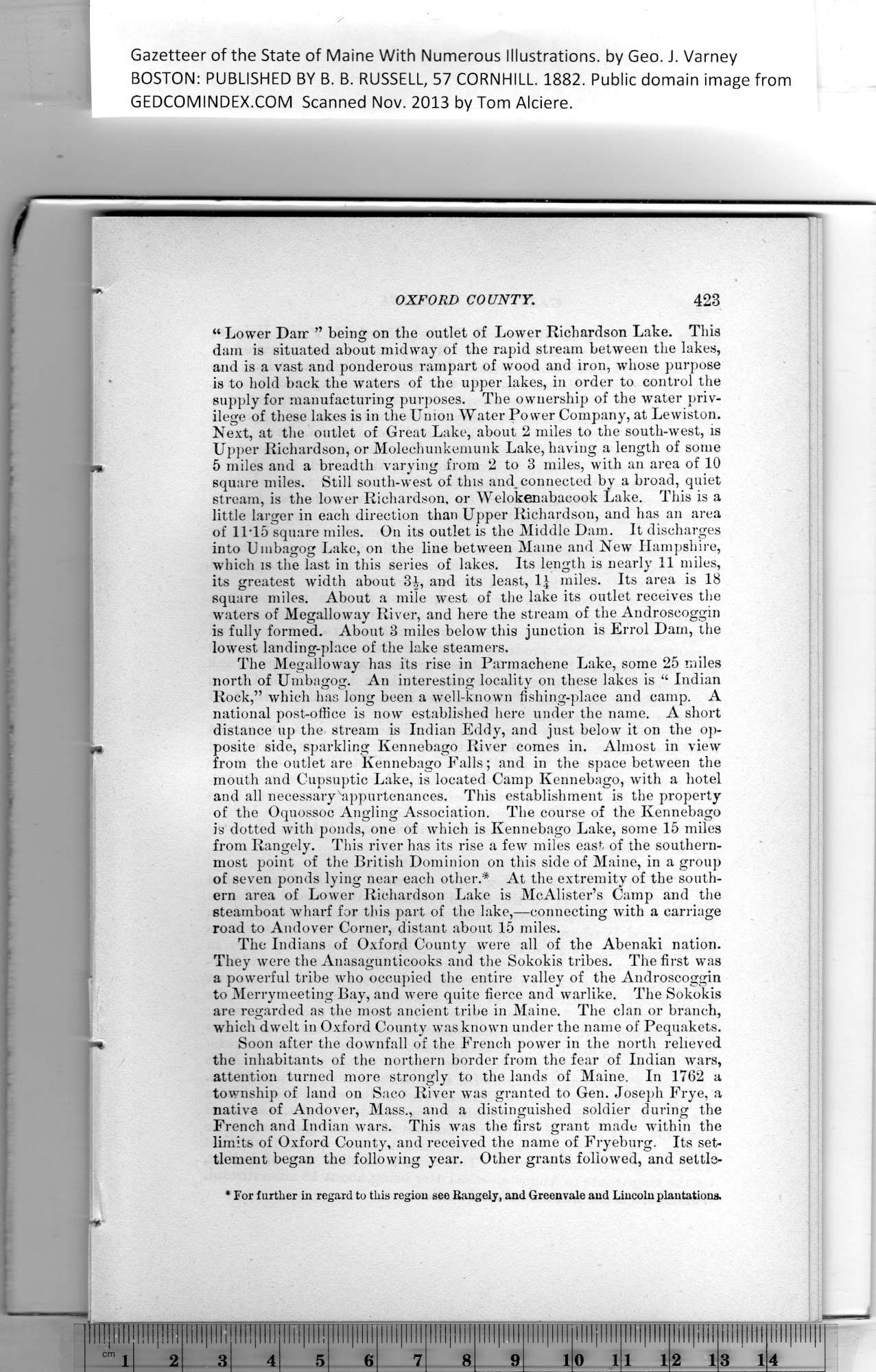|
Gazetteer of the State of Maine With Numerous Illustrations, by Geo. J. Varney
BOSTON: PUBLISHED BY B. B. RUSSELL, 57 CORNHILL. 1882. Public domain image from
OXFORD COUNTY.
“ Lower Dair ” being on the outlet of Lower Richardson Lake. This
dam is situated about midway of the rapid stream between the lakes,
and is a vast and ponderous rampart of wood and iron, whose purpose
is to hold back the waters of the upper lakes, in order to control the
supply for manufacturing purposes. The ownership of the water priv-
ilege of these lakes is in the Union Water Power Company, at Lewiston.
Next, at the outlet of Great Lake, about 2 miles to the south-west, is
Upper Richardson, or Molechunkemunk Lake, having a length of some
5 miles and a breadth varying from 2 to 3 miles, with an area of 10
square miles. Still south-west of this and connected by a broad, quiet
stream, is the lower Richardson, or Welokenabacook Lake. This is a
little larger in each direction than Upper Richardson, and has an area
of 11115 square miles. On its outlet is the Middle Dam. It discharges
into Umbagog Lake, on the line between Maine and New Hampshire,
which is the last in this series of lakes. Its length is nearly 11 miles,
its greatest width about 3|, and its least, miles. Its area is 18
square miles. About a mile west of the lake its outlet receives the
waters of Megalloway River, and here the stream of the Androscoggin
is fully formed. About 3 miles below this junction is Errol Dam, the
lowest landing-place of the lake steamers.
The Megalloway has its rise in Parmachene Lake, some 25 miles
north of Umbagog. An interesting locality on these lakes is “ Indian
Rock,” which has long been a well-known fishing-place and camp. A
national post-office is now established here under the name. A short
distance up the stream is Indian Eddy, and just below it on the op-
posite side, sparkling Kennebago River comes in. Almost in view
from the outlet are Kennebago Falls; and in the space between the
mouth and Cupsuptic Lake, is located Camp Kennebago, with a hotel
and all necessary'appurtenances. This establishment is the property
of the Oquossoc Angling Association. The course of the Kennebago
is dotted with ponds, one of which is Kennebago Lake, some 15 miles
from Rangely. This river has its rise a few miles east of the southern-
most point of the British Dominion on this side of Maine, in a group
of seven ponds lying near each other.* At the extremity of the south-
ern area of Lower Richardson Lake is McAlister’s Camp and the
steamboat wharf for this part of the lake,—connecting with a carriage
road to Andover Corner, distant about 15 miles.
The Indians of Oxford County were all of the Abenaki nation.
They were the Anasagunticooks and the Sokokis tribes. The first was
a powerful tribe who occupied the entire valley of the Androscoggin
to Merrymeeting Bay, and were quite fierce and warlike. The Sokokis
are regarded as the most ancient tribe in Maine. The clan or branch,
which dwelt in Oxford County was known under the name of Pequakets.
Soon after the downfall of the French power in the north relieved
the inhabitants of the northern border from the fear of Indian wars,
attention turned more strongly to the lands of Maine. In 1762 a
township of land on Saco River was granted to Gen. Joseph Frye, a
native of Andover, Mass., and a distinguished soldier during the
French and Indian wars. This was the first grant made within the
limits of Oxford County, and received the name of Fryeburg. Its set-
tlement began the following year. Other grants followed, and settlo-
1
For further in regard to this region see Rangely, and Greenvale and Lincoln plantations.
PREVIOUS PAGE ... NEXT PAGE
This page was written in HTML using a program written in Python 3.2
|
